Common brushtail possum on:
[Wikipedia]
[Google]
[Amazon]
The common brushtail possum (''Trichosurus vulpecula'', from the Greek for "furry tailed" and the

 The common brushtail possum has large and pointed ears. Its bushy tail (hence its name) is adapted to grasping branches, prehensile at the end with a hairless ventral patch. Its fore feet have sharp claws and the first toe of each hind foot is clawless, but has a strong grasp. The possum grooms itself with the third and fourth toes which are fused together. It has a thick and woolly pelage that varies in colour depending on the subspecies. Colour patterns tend to be silver-grey, brown, black, red, or cream. The ventral areas are typically lighter and the tail is usually brown or black. The muzzle is marked with dark patches.
The common brushtail possum has a head and body length of 32–58 cm with a tail length of 24–40 cm. It weighs 1.2-4.5 kg. Males are generally larger than females. In addition, the coat of the male tends to be reddish at the shoulders. As with most marsupials, the female brushtail possum has a forward-opening, well-developed pouch. The chest of both sexes has a scent gland that emits a reddish secretion which stains that fur around it. It marks its territory with these secretions.
The common brushtail possum has large and pointed ears. Its bushy tail (hence its name) is adapted to grasping branches, prehensile at the end with a hairless ventral patch. Its fore feet have sharp claws and the first toe of each hind foot is clawless, but has a strong grasp. The possum grooms itself with the third and fourth toes which are fused together. It has a thick and woolly pelage that varies in colour depending on the subspecies. Colour patterns tend to be silver-grey, brown, black, red, or cream. The ventral areas are typically lighter and the tail is usually brown or black. The muzzle is marked with dark patches.
The common brushtail possum has a head and body length of 32–58 cm with a tail length of 24–40 cm. It weighs 1.2-4.5 kg. Males are generally larger than females. In addition, the coat of the male tends to be reddish at the shoulders. As with most marsupials, the female brushtail possum has a forward-opening, well-developed pouch. The chest of both sexes has a scent gland that emits a reddish secretion which stains that fur around it. It marks its territory with these secretions.
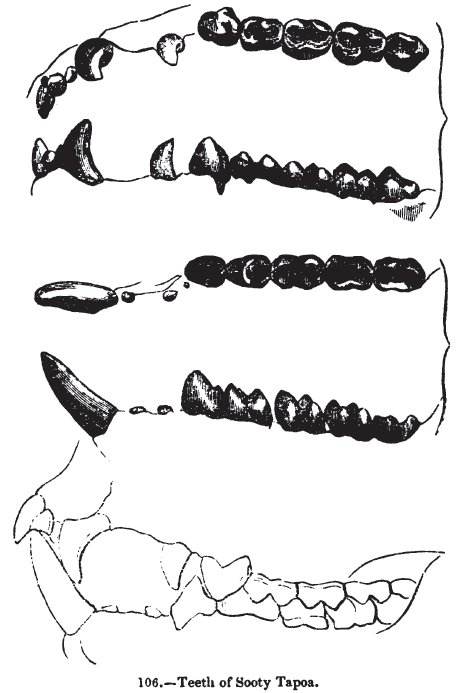 The common brushtail possum can adapt to numerous kinds of vegetation but it is largely
The common brushtail possum can adapt to numerous kinds of vegetation but it is largely 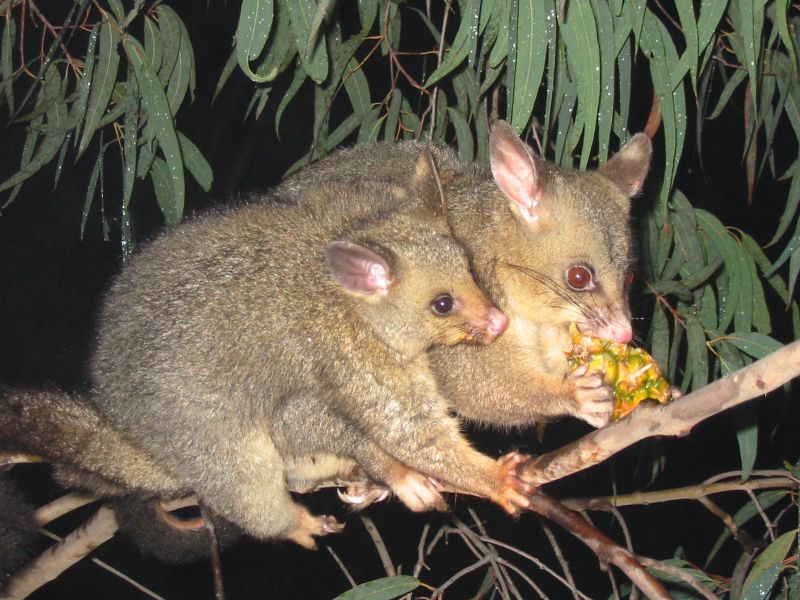
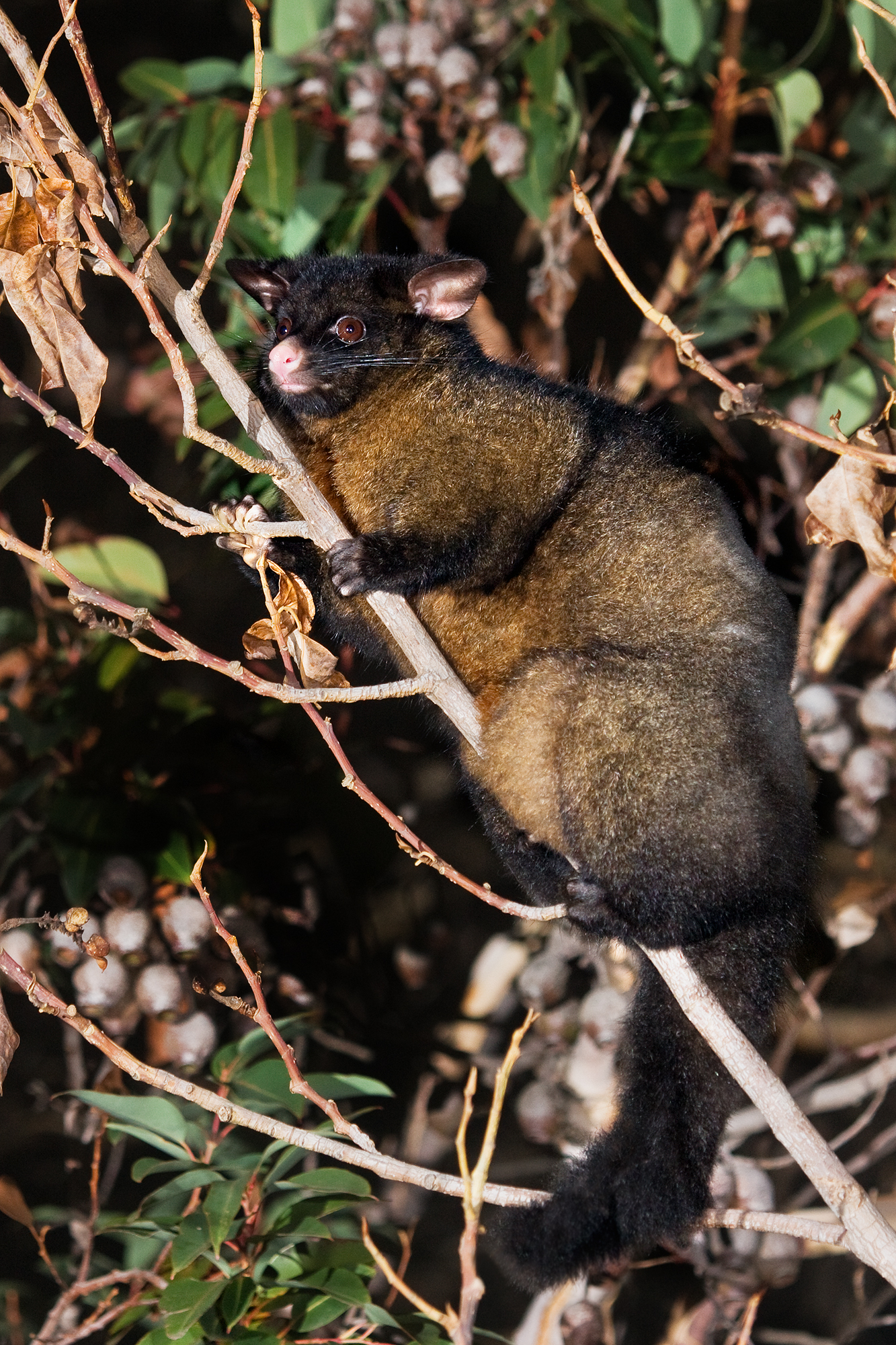 The common brushtail possum is largely arboreal and nocturnal. It has a mostly solitary lifestyle, and individuals keep their distance with scent markings (urinating) and vocalisations. They usually make their dens in natural places such as tree hollows and caves, but also use spaces in the roofs of houses. While they sometimes share dens, brushtails normally sleep in separate dens. Individuals from New Zealand use many more den sites than those from Australia. Brushtail possums compete with each other and other animals for den spaces, and this contributes to their mortality. This is likely another reason why brushtail possum population densities are smaller in Australia than in New Zealand. Brushtail possums are usually not aggressive towards each other and usually just stare with erect ears. They vocalise with clicks, grunts, hisses, alarm chatters, guttural coughs, and screeching.
The common brushtail possum is largely arboreal and nocturnal. It has a mostly solitary lifestyle, and individuals keep their distance with scent markings (urinating) and vocalisations. They usually make their dens in natural places such as tree hollows and caves, but also use spaces in the roofs of houses. While they sometimes share dens, brushtails normally sleep in separate dens. Individuals from New Zealand use many more den sites than those from Australia. Brushtail possums compete with each other and other animals for den spaces, and this contributes to their mortality. This is likely another reason why brushtail possum population densities are smaller in Australia than in New Zealand. Brushtail possums are usually not aggressive towards each other and usually just stare with erect ears. They vocalise with clicks, grunts, hisses, alarm chatters, guttural coughs, and screeching.
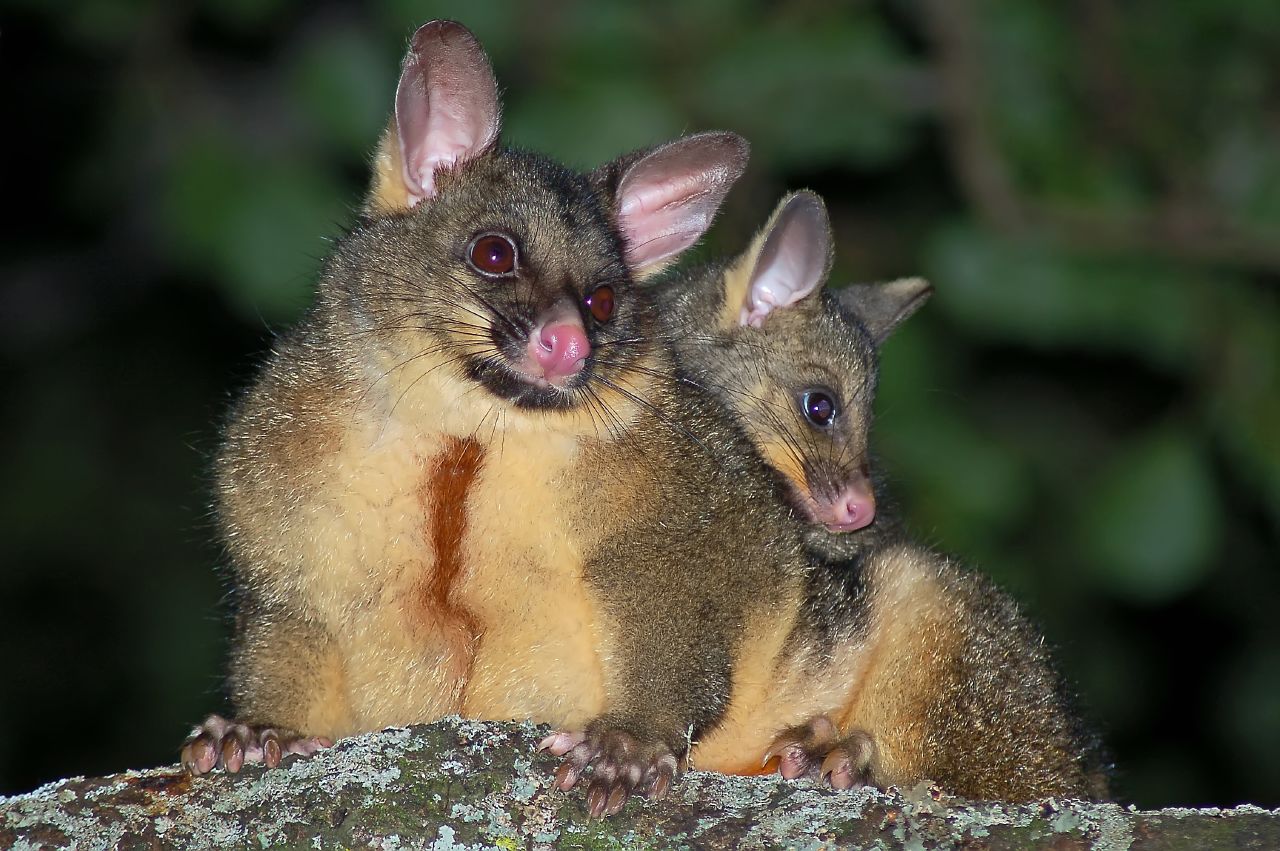 The common brushtail possum can breed at any time of the year, but breeding tends to peak in spring, from September to November, and in autumn, from March to May, in some areas. Mating is promiscuous and random; some males can sire several young in a season, while over half sire none. In one Queensland population, males apparently need a month of consorting with females before they can mate with them. Females have a gestation period of 16–18 days, after which they give birth to single young. A newborn brushtail possum is only 1.5 cm long and weighs only 2 g. As usual for marsupials, the newborn may climb, unaided, through the female's fur and into the pouch and attach to a teat. The young develops and remains inside the mother's pouch for another 4–5 months. When older, the young is left in the den or rides on its mother's back until it is 7–9 months old. Females reach sexual maturity when they are a year old, and males do so at the end of their second year. Brushtail possums can live up to 13 years in the wild.
Female young have a higher survival rate than their male counterparts due to establishing their home ranges closer to their mothers, while males travel farther in search of new nesting sites, encountering established territories from which they may be forcibly ejected. In New Zealand's Ōrongorongo population, female young have been found to continue to associate with their mothers after weaning, and some inherit the prime den sites. A possible competition exists between mothers and daughters for dens, and daughters may be excluded from a den occupied by the mother. In forests with shortages of den sites, females apparently produce more sons, which do not compete directly for den sites, while in forests with plentiful den sites, female young are greater in number.
The common brushtail possum can breed at any time of the year, but breeding tends to peak in spring, from September to November, and in autumn, from March to May, in some areas. Mating is promiscuous and random; some males can sire several young in a season, while over half sire none. In one Queensland population, males apparently need a month of consorting with females before they can mate with them. Females have a gestation period of 16–18 days, after which they give birth to single young. A newborn brushtail possum is only 1.5 cm long and weighs only 2 g. As usual for marsupials, the newborn may climb, unaided, through the female's fur and into the pouch and attach to a teat. The young develops and remains inside the mother's pouch for another 4–5 months. When older, the young is left in the den or rides on its mother's back until it is 7–9 months old. Females reach sexual maturity when they are a year old, and males do so at the end of their second year. Brushtail possums can live up to 13 years in the wild.
Female young have a higher survival rate than their male counterparts due to establishing their home ranges closer to their mothers, while males travel farther in search of new nesting sites, encountering established territories from which they may be forcibly ejected. In New Zealand's Ōrongorongo population, female young have been found to continue to associate with their mothers after weaning, and some inherit the prime den sites. A possible competition exists between mothers and daughters for dens, and daughters may be excluded from a den occupied by the mother. In forests with shortages of den sites, females apparently produce more sons, which do not compete directly for den sites, while in forests with plentiful den sites, female young are greater in number.


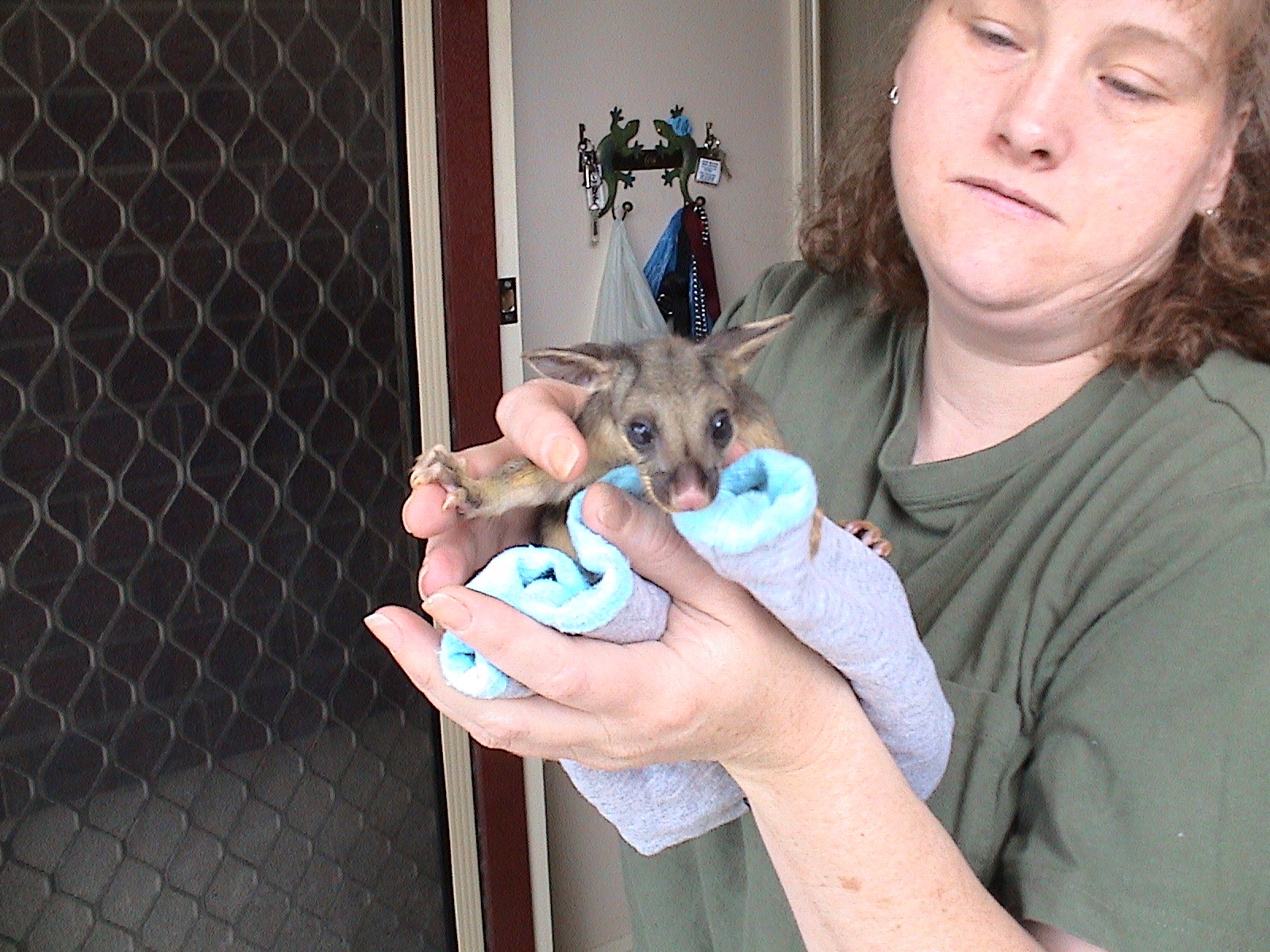 The common brushtail possum is considered a pest in some areas, as it is known to cause damage to pine plantations, regenerative forest, flowers, fruit trees, and buildings. Like other
The common brushtail possum is considered a pest in some areas, as it is known to cause damage to pine plantations, regenerative forest, flowers, fruit trees, and buildings. Like other
Blog.forestandbird.org.nzBrushtail possumLandcare Research NZCommon brushtail possum (''Trichosurus vulpecula'')
at ARKive
PossumBase
{{Taxonbar, from=Q732477 Possums Mammals described in 1792 Mammals of Tasmania Mammals of Western Australia Mammals of South Australia Mammals of the Northern Territory Mammals of Queensland Mammals of New South Wales Marsupials of Australia Mammals of New Zealand
Latin
Latin (, or , ) is a classical language belonging to the Italic languages, Italic branch of the Indo-European languages. Latin was originally a dialect spoken in the lower Tiber area (then known as Latium) around present-day Rome, but through ...
for "little fox", previously in the genus ''Phalangista'') is a nocturnal
Nocturnality is an animal behavior characterized by being active during the night and sleeping during the day. The common adjective is "nocturnal", versus diurnal meaning the opposite.
Nocturnal creatures generally have highly developed sens ...
, semiarboreal
Arboreal locomotion is the locomotion of animals in trees. In habitats in which trees are present, animals have evolved to move in them. Some animals may scale trees only occasionally, but others are exclusively arboreal. The habitats pose nu ...
marsupial
Marsupials are any members of the mammalian infraclass Marsupialia. All extant marsupials are endemic to Australasia, Wallacea and the Americas. A distinctive characteristic common to most of these species is that the young are carried in ...
of the family Phalangeridae, native to Australia
Australia, officially the Commonwealth of Australia, is a sovereign country comprising the mainland of the Australian continent, the island of Tasmania, and numerous smaller islands. With an area of , Australia is the largest country by ...
and naturalised in New Zealand
New Zealand ( mi, Aotearoa ) is an island country in the southwestern Pacific Ocean. It consists of two main landmasses—the North Island () and the South Island ()—and over 700 smaller islands. It is the sixth-largest island coun ...
, and the second-largest of the possums
Possum may refer to:
Animals
* Phalangeriformes, or possums, any of a number of arboreal marsupial species native to Australia, New Guinea, and Sulawesi
** Common brushtail possum (''Trichosurus vulpecula''), a common possum in Australian urban ...
.
Like most possums, the common brushtail possum is nocturnal. It is mainly a folivore, but has been known to eat small mammals such as rats. In most Australian habitats, eucalyptus
''Eucalyptus'' () is a genus of over seven hundred species of flowering trees, shrubs or mallees in the myrtle family, Myrtaceae. Along with several other genera in the tribe Eucalypteae, including '' Corymbia'', they are commonly known as ...
leaves are a significant part of the diet, but rarely the sole item eaten. Its tail is prehensile
Prehensility is the quality of an appendage or organ that has adapted for grasping or holding. The word is derived from the Latin term ''prehendere'', meaning "to grasp". The ability to grasp is likely derived from a number of different orig ...
and naked on its lower underside. The four colour variations are silver-grey, brown, black, and gold.
It is the Australian marsupial
Marsupials are any members of the mammalian infraclass Marsupialia. All extant marsupials are endemic to Australasia, Wallacea and the Americas. A distinctive characteristic common to most of these species is that the young are carried in ...
most often seen by city dwellers, as it is one of few that thrive in cities and a wide range of natural and human-modified environments. Around human habitations, common brushtails are inventive and determined foragers with a liking for fruit trees, vegetable gardens, and kitchen raids.
The common brushtail possum was introduced to New Zealand in the 1850s to establish a fur industry, but in the mild subtropical climate of New Zealand, and with few to no natural predators, it thrived to the extent that it became a major agricultural and conservation pest.
Description

Biology and ecology
Range and habitat
The common brushtail possum is perhaps the most widespread marsupial of Australia. It is found throughout the eastern and northern parts of the continent, as well as some western regions, Tasmania and a number of offshore islands, such asKangaroo Island
Kangaroo Island, also known as Karta Pintingga (literally 'Island of the Dead' in the language of the Kaurna people), is Australia's third-largest island, after Tasmania and Melville Island. It lies in the state of South Australia, southwest ...
and Barrow Island. It is also widespread in New Zealand since its introduction in 1850. The common brushtail possum can be found in a variety of habitats, such as forests, semi-arid areas and even cultivated or urban areas. It is mostly a forest inhabiting species, however it is also found in treeless areas. In New Zealand, possums favour broadleaf-podocarp near farmland pastures. In southern beech forests and pine plantations, possums are less common. Overall, brushtail possums are more densely populated in New Zealand than in their native Australia. This may be because Australia has more fragmented eucalypt
Eucalypt is a descriptive name for woody plants with capsule fruiting bodies belonging to seven closely related genera (of the tribe Eucalypteae) found across Australasia:
''Eucalyptus'', ''Corymbia'', ''Angophora'', '' Stockwellia'', ''Allosyn ...
forests and more predators. In Australia, brushtail possums are threatened by humans, tiger quoll
The tiger quoll (''Dasyurus maculatus''), also known as the spotted-tail quoll, the spotted quoll, the spotted-tail dasyure, native cat or the tiger cat, is a carnivorous marsupial of the quoll genus '' Dasyurus'' native to Australia. With male ...
s, dogs, foxes, cats, goannas, carpet snakes, and powerful owl
The powerful owl (''Ninox strenua''), a species of owl native to south-eastern and eastern Australia, is the largest owl on the continent. It is found in coastal areas and in the Great Dividing Range, rarely more than inland. The IUCNRed List ...
s. In New Zealand, brushtail possums are threatened only by humans and cats. The IUCN highlight the population trend in Australia as decreasing.
Food and foraging
 The common brushtail possum can adapt to numerous kinds of vegetation but it is largely
The common brushtail possum can adapt to numerous kinds of vegetation but it is largely omnivorous
An omnivore () is an animal that has the ability to eat and survive on both plant and animal matter. Obtaining energy and nutrients from plant and animal matter, omnivores digest carbohydrates, protein, fat, and fiber, and metabolize the nut ...
. It prefers ''Eucalyptus
''Eucalyptus'' () is a genus of over seven hundred species of flowering trees, shrubs or mallees in the myrtle family, Myrtaceae. Along with several other genera in the tribe Eucalypteae, including '' Corymbia'', they are commonly known as ...
'' leaves, but also eats flowers, shoots, fruits, and seeds. It may also consume animal matter such as insects, birds' eggs and chicks, and other small vertebrates. Brushtail possums may eat three or four different plant species during a foraging trip, unlike some other arboreal marsupials, such as the koala
The koala or, inaccurately, koala bear (''Phascolarctos cinereus''), is an arboreal herbivorous marsupial native to Australia. It is the only extant representative of the family Phascolarctidae and its closest living relatives are the ...
and the greater glider
The greater gliders are three species of large gliding marsupials in the genus ''Petauroides'', all of which are found in eastern Australia. Until 2020 they were considered to be one species, ''Petauroides volans''. In 2020 morphological and gene ...
, which focus on single species. The brushtail possum's rounded molars cannot cut ''Eucalyptus'' leaves as finely as more specialised feeders. They are more adapted to crushing their food, which enables them to chew fruit or herbs more effectively. The brushtail possums' caecum lacks internal ridges and cannot separate coarse and fine particles as efficiently as some other arboreal marsupials. The brushtail possum cannot rely on ''Eucalyptus'' alone to provide sufficient protein. Its more generalised and mixed diet, however, does provide adequate nitrogen.

Behaviour
 The common brushtail possum is largely arboreal and nocturnal. It has a mostly solitary lifestyle, and individuals keep their distance with scent markings (urinating) and vocalisations. They usually make their dens in natural places such as tree hollows and caves, but also use spaces in the roofs of houses. While they sometimes share dens, brushtails normally sleep in separate dens. Individuals from New Zealand use many more den sites than those from Australia. Brushtail possums compete with each other and other animals for den spaces, and this contributes to their mortality. This is likely another reason why brushtail possum population densities are smaller in Australia than in New Zealand. Brushtail possums are usually not aggressive towards each other and usually just stare with erect ears. They vocalise with clicks, grunts, hisses, alarm chatters, guttural coughs, and screeching.
The common brushtail possum is largely arboreal and nocturnal. It has a mostly solitary lifestyle, and individuals keep their distance with scent markings (urinating) and vocalisations. They usually make their dens in natural places such as tree hollows and caves, but also use spaces in the roofs of houses. While they sometimes share dens, brushtails normally sleep in separate dens. Individuals from New Zealand use many more den sites than those from Australia. Brushtail possums compete with each other and other animals for den spaces, and this contributes to their mortality. This is likely another reason why brushtail possum population densities are smaller in Australia than in New Zealand. Brushtail possums are usually not aggressive towards each other and usually just stare with erect ears. They vocalise with clicks, grunts, hisses, alarm chatters, guttural coughs, and screeching.
Reproduction and life history
 The common brushtail possum can breed at any time of the year, but breeding tends to peak in spring, from September to November, and in autumn, from March to May, in some areas. Mating is promiscuous and random; some males can sire several young in a season, while over half sire none. In one Queensland population, males apparently need a month of consorting with females before they can mate with them. Females have a gestation period of 16–18 days, after which they give birth to single young. A newborn brushtail possum is only 1.5 cm long and weighs only 2 g. As usual for marsupials, the newborn may climb, unaided, through the female's fur and into the pouch and attach to a teat. The young develops and remains inside the mother's pouch for another 4–5 months. When older, the young is left in the den or rides on its mother's back until it is 7–9 months old. Females reach sexual maturity when they are a year old, and males do so at the end of their second year. Brushtail possums can live up to 13 years in the wild.
Female young have a higher survival rate than their male counterparts due to establishing their home ranges closer to their mothers, while males travel farther in search of new nesting sites, encountering established territories from which they may be forcibly ejected. In New Zealand's Ōrongorongo population, female young have been found to continue to associate with their mothers after weaning, and some inherit the prime den sites. A possible competition exists between mothers and daughters for dens, and daughters may be excluded from a den occupied by the mother. In forests with shortages of den sites, females apparently produce more sons, which do not compete directly for den sites, while in forests with plentiful den sites, female young are greater in number.
The common brushtail possum can breed at any time of the year, but breeding tends to peak in spring, from September to November, and in autumn, from March to May, in some areas. Mating is promiscuous and random; some males can sire several young in a season, while over half sire none. In one Queensland population, males apparently need a month of consorting with females before they can mate with them. Females have a gestation period of 16–18 days, after which they give birth to single young. A newborn brushtail possum is only 1.5 cm long and weighs only 2 g. As usual for marsupials, the newborn may climb, unaided, through the female's fur and into the pouch and attach to a teat. The young develops and remains inside the mother's pouch for another 4–5 months. When older, the young is left in the den or rides on its mother's back until it is 7–9 months old. Females reach sexual maturity when they are a year old, and males do so at the end of their second year. Brushtail possums can live up to 13 years in the wild.
Female young have a higher survival rate than their male counterparts due to establishing their home ranges closer to their mothers, while males travel farther in search of new nesting sites, encountering established territories from which they may be forcibly ejected. In New Zealand's Ōrongorongo population, female young have been found to continue to associate with their mothers after weaning, and some inherit the prime den sites. A possible competition exists between mothers and daughters for dens, and daughters may be excluded from a den occupied by the mother. In forests with shortages of den sites, females apparently produce more sons, which do not compete directly for den sites, while in forests with plentiful den sites, female young are greater in number.

Relationship with humans
possums
Possum may refer to:
Animals
* Phalangeriformes, or possums, any of a number of arboreal marsupial species native to Australia, New Guinea, and Sulawesi
** Common brushtail possum (''Trichosurus vulpecula''), a common possum in Australian urban ...
, it is rather tolerant of humans and can sometimes be hand fed, although it is not encouraged, as their claws are quite sharp and can cause infection or disease to humans if scratched. It is a traditional food source for some indigenous Australians.
Australia
Its fur has been considered valuable and has been harvested. Although once hunted extensively for its fur in Australia, the common brushtail possum is now protected in mainland states, but it has only been partially protected in Tasmania, where an annual hunting season is used. In addition, Tasmania gives crop-protection permits to landowners whose property has been damaged. While its populations are declining in some regions due to habitat loss, urban populations indicate an adaptation to the presence of humans. In some mainland states, possum trapping is legal to catch when attempting to evict possums from human residences (e.g. roofs), but possums must be released after dusk within 24 hours of capture, no more than 50 m from the trapping site. In some states, e.g. Victoria, trapped possums may be taken to registered veterinarians for euthanasia. In South Australia, they are fully protected and permits are required for trapping possums in human residences or for keeping or rescuing sick or injured wild possums and other native animals. In Queensland, they can only be trapped by licensed commercial relocators who must release possums within 25 metres of the point of capture to ensure that an animal is not released into another possum's home range (possums are less likely to survive if they are released into a new area where they do not have access to a den or must compete with a neighbouring possum for den space).New Zealand
Since itsintroduction
Introduction, The Introduction, Intro, or The Intro may refer to:
General use
* Introduction (music), an opening section of a piece of music
* Introduction (writing), a beginning section to a book, article or essay which states its purpose and ...
from Australia by European settlers in the 1850s, the common brushtail possum has become a major threat to New Zealand native forests and birds. It is also a host for the highly contagious bovine tuberculosis. (This is not an issue in Australia, where the disease has been eradicated.)
By the 1980s, the peak population had reached an estimated 60–70 million, but is now down to an estimated 30 million due to control measures. The New Zealand Department of Conservation controls possum numbers in many areas via the aerial dropping of 1080-laced bait. Hunting is not restricted, but the population seems to be stable despite the annual killing of thousands of the animals.
References
Further reading
*Marsh, K. J., Wallis, I. R., & Foley, W. J. (2003). The effect of inactivating tannins on the intake of Eucalyptus foliage by a specialist Eucalyptus folivore (''Pseudocheirus peregrinus'') and a generalist herbivore (''Trichosurus vulpecula''). ''Australian Journal of Zoology, 51'', 41–42.External links
Blog.forestandbird.org.nz
at ARKive
PossumBase
{{Taxonbar, from=Q732477 Possums Mammals described in 1792 Mammals of Tasmania Mammals of Western Australia Mammals of South Australia Mammals of the Northern Territory Mammals of Queensland Mammals of New South Wales Marsupials of Australia Mammals of New Zealand